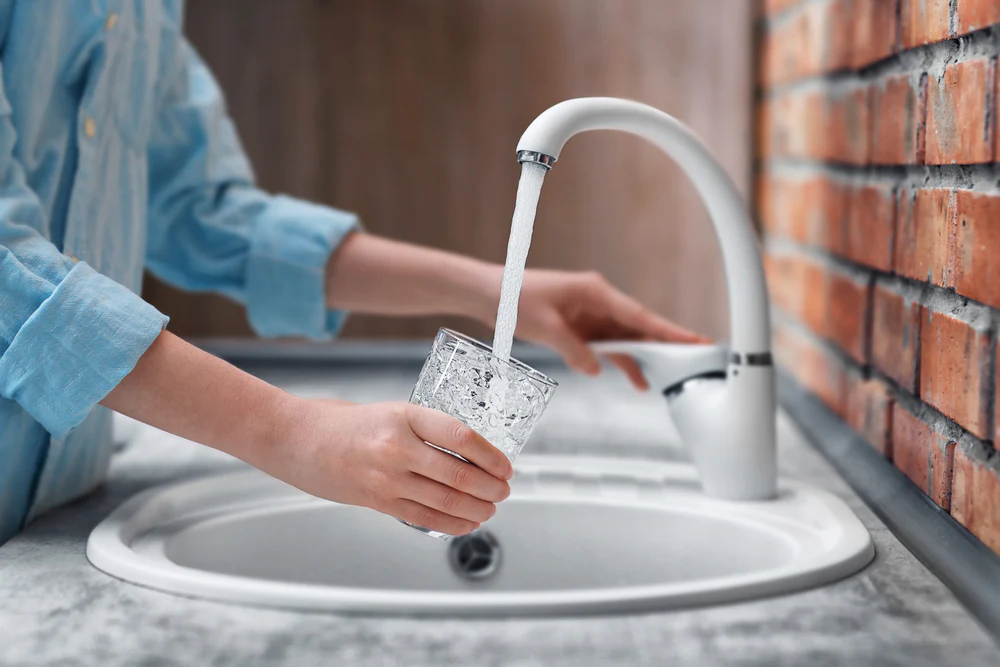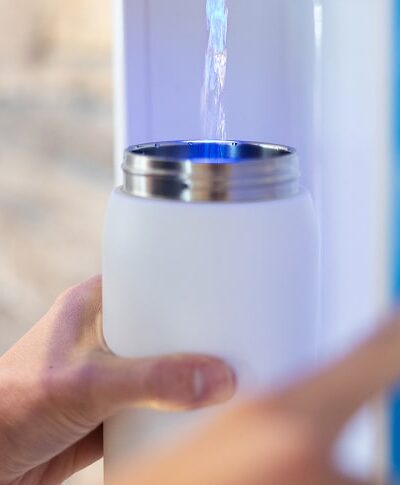Updated July 7 2024
Have you ever stopped to consider what’s in your tap water? Have you thought about what is picked up as it makes its way from the original source, through old city pipes and into your faucet? While most cities have safe drinking water, it doesn’t mean there aren’t contaminants and pollutants coming from your tap. According to the U.S. Environmental Protection Agency (EPA), the National Primary Drinking Water Regulations limit the levels of contaminants in drinking water, but do not eliminate them fully.
Urban water pollution, in particular, can be caused by a myriad of sources, from sewage to industrial runoff and commercial disposal to stormwater, which carries oil, grease, toxic chemicals, and other debris from highways and local streets. Cities close to agricultural areas may also have groundwater sources that have been contaminated by pesticides, herbicides, and other chemicals and bacteria.
Knowing the source and quality of your water can help you decide whether or not you want to rely on drinking from the tap. Fortunately, technology has created alternatives that provide families with purified water solutions available right in their own home.
Activities That Contribute to Urban Water Pollution
According to the EPA, there are five main activity types that contribute to water and environmental pollution. They are agricultural, commercial, industrial, residential, and other (mostly stemming from a city’s road and landfill systems). The larger the area, the greater number of people and cars that contribute to the runoff waste that makes its way into your water.
Commercial
There’s a long list of commercial businesses that contribute to urban water pollution daily. Airports, gas stations, auto repair shops, and construction sites are among the most common culprits found in nearly every major city. This leads to a mix of chemicals, oils, and other pollutants that are part of their daily operations and make their way into the ground and sewer systems, and eventually water sources.
Industrial
Big cities known for their industrial production are notorious for leaking waste, heavy metals, and chemicals into the water. One of the most notorious examples is Perfluorooctanoic acid or PFAS, which are manmade chemicals largely used to make non-stick cookware and other household products. Studies suggest that water supplies in certain counties of North Carolina and Iowa contain the highest levels of these heavy metals and chemicals, which do not break down once they’re in the urban environment. Although use of these chemicals were phased out beginning in 2006, high levels could still remain in previously high saturated areas.
Residential
Regular household products can also contribute to urban water pollution through lawn fertilizer, swimming pool chemicals, septic tank drainage, and other pollutants that may make their way into the water source. Even if each household has a minimum waste contribution, this amount is multiplied when there are millions of people relying on the same water source. A little individually quickly becomes a collective lot.
Commercial, industrial, and residential are the three main activities big cities should be concerned about when it comes to water contamination, but that’s not to say they don’t face equal risk from nearby agricultural facilities or the everyday waste that accumulates from storm water pipes and drains, illegal dumping, and road de-icing chemicals.
The amount of these types of contaminants from these categories is largely dependent on the region, weather patterns, and waste disposal. For instance, in an area like the Pacific Northwest, where it rains the majority of the year, the runoff that accumulates may be far greater because it’s washing away everything that’s on the road, landfills, and dirt surfaces and mixes in with the natural water source.
Chemicals with a Higher Level in City Water
Due to the biggest industries that contribute to urban water pollution, there are certain chemicals that often have much higher levels in city water than in rural areas. Chemicals most largely found in city water are lead, household products, and disinfection byproducts. These pollution sources can spread toxic chemicals in water sources throughout the city.
Lead
Replacing a city’s water system is expensive and time-consuming, which is why many cities have old pipes, made of lead, which can leach into the water, due to corrosion, and make its way to your faucet. Due to these older pipes, lead in drinking water can be more common than one might expect. This can also occur with outdated pipe systems in the home.
According to the EPA, drinking water is a known source of lead exposure among children in the U.S., particularly in children who consume baby formula prepared with drinking water that’s been contaminated by lead pipes. Since their immune systems haven’t fully developed, they are at greater risk of adverse health effects, such as low birth weight and underdeveloped cognitive functioning.
Household Products
Herbicides used in agricultural production are a large contributor. However, it can come from commercial and residential use as well when people tend to their yards. Additionally, chemical solvents used in paint remover, degreasing agents, and other kitchen, bathroom, and household projects contain a range of chemicals that make their way into the water supply. This can irritate and harm the body both externally and internally, causing damage to heart, kidney, and other internal organs.
Bigger cities have more use of this from the larger number of households that use these and also the number of commercial businesses, including construction, restaurants, and other industries that use these regularly and in large amounts.
Disinfection Byproducts
When drinking water doesn’t meet the limitation set forth by the EPA, it must go through a treatment process that removes many of these contaminants, although leaves behind disinfection byproducts that can also be potentially harmful. These include chlorine, bromate (which carries an increased risk of cancer) and total trihalomethanes (which carry an increased risk of cancer, as well as liver, kidney, and central nervous system problems), among others.
Lead, household products, and disinfection byproducts are a few of the many chemicals commonly found in city drinking water, in addition to bacteria, viruses, and other pollutants. Each year, city water departments are supposed to make Consumer Confidence Reports available to the public, which outlines the type and level of contaminants found in the water. However, levels fluctuate with the amount of contamination at the source, which can vary between scheduled water testings.
According to a report from Business Insider, a chemical spill in Charleston, West Virginia affected the city’s drinking water in 2014, with officials still concerned about water quality several years later. Newark, New Jersey showed lead levels that exceed the EPA’s threshold from 2017 to 2019, as well as high levels of an acid that can form during the water disinfecting process, which can lead to skin irritation and potentially increase the risk of cancer. Meanwhile, Milwaukee, Wisconsin, Flint, Michigan, and Washington D.C. are other metropolitan areas that have faced problems with lead-contaminated water within recent years.
There are regulations in place to reduce the amount of contaminants in drinking water as much as possible, but these vary based on a city’s testing protocols, age of the water system and pipes, water source, and disinfectant processes. Not all cities follow the same schedule or process.
Providing Clean Drinking Water for Families
Cities use different sources for their main water supplies and various disinfectant products to provide clean drinking water for their communities. However, despite best efforts, there’s still contamination found in water that comes from the tap, some more than others, which can lead to adverse health effects.
Many of the chemicals and pollutants consumed through contaminated water accumulate in the body over the time, meaning it’s still harmful even if consumed in small amounts on an ongoing basis. Since we are exposed to chemicals in the air, through the foods we eat, and the materials we use on a daily basis, limiting this whenever possible is beneficial.
To eliminate the risk associated with the low quality of water found in many major cities, it’s best to have a purified water solution that people can use in their home without resorting to buying plastic bottles of water. The FloWater Faucet Filter transforms tap water by removing or reducing over 80 known contaminants most commonly found in city water systems. It uses a five-stage micro carbon block filtering process on compatible faucets that captures chemicals and pollutants, as well as unpleasant odors.
The result is great-tasting water and using your sink as the source. It’s an affordable, easy-to-install, and easy-to-use option for all and saves approximately $700 per year when compared to the cost of drinking bottled water. Plus, it doesn’t contribute to the increasing amount of plastic waste that’s affecting the urban environment today.
Fill up a reusable container for kids to take to school or adults to take to work rather than relying on bottled water or turning to sugary sodas or energy drinks instead. It’s a simple, low-maintenance way to provide clean drinking water for at home and to take with them on-the-go. Purified water is then also available in plentiful supply, which encourages families to drink more water and rely on it when cooking or baking, too.
The FloFaucet provides an essential need for families that’s convenient and cost-effective. With many cities facing water contamination crises, it’s better to know that municipal-treated water is being filtered at the tap for a refreshing, healthy experience.
Sources:
https://www.epa.gov/ground-water-and-drinking-water/national-primary-drinking-water-regulations
https://www.epa.gov/privatewells/potential-well-water-contaminants-and-their-impacts
https://www.cnn.com/2020/01/24/health/forever-chemicals-drinking-water-supplies-trnd/index.html
https://www.epa.gov/sites/production/files/2015-10/documents/ace3_drinking_water.pdf
https://www.businessinsider.com/cities-worst-tap-water-us-2019-3




